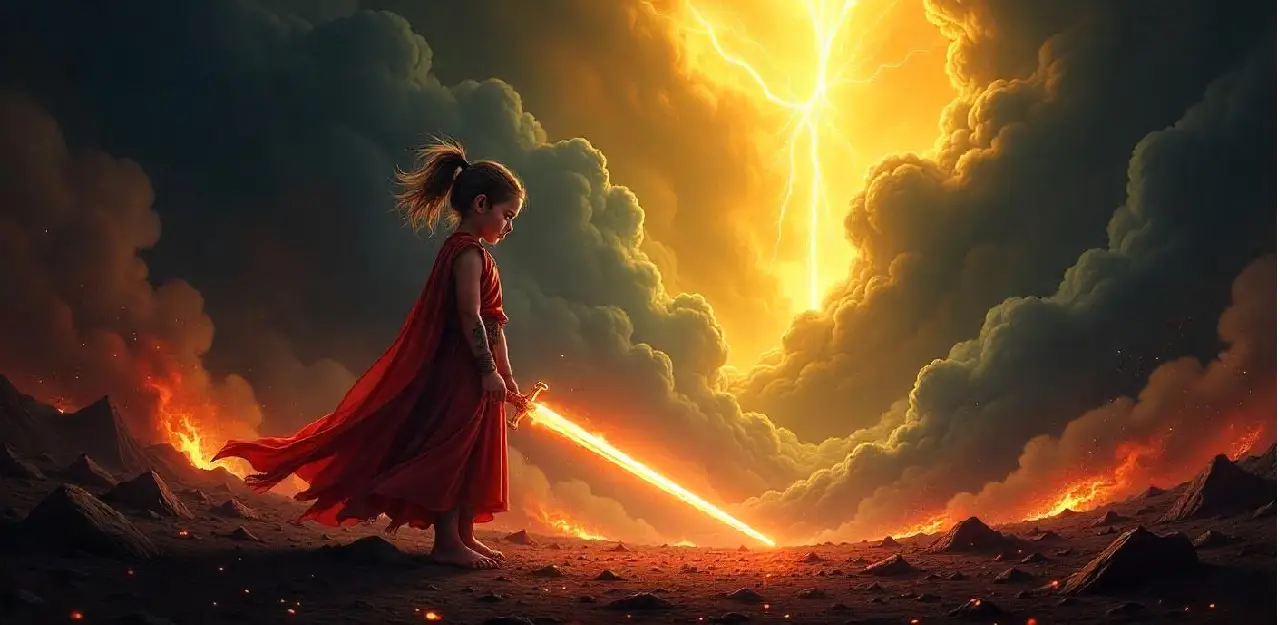What happens when the divine rejects its own offspring? This enigma serves as the foundation of “The Disowned Child: Chronicles of Unleashed Divine Bloodlust,” drawing you into a tale where divine scorn transforms into an unparalleled vendetta. The chronicles challenge you to explore the capacity for rage and rebellion inherent in those cast aside by their celestial origin.
Rooted in ancient mythology, these narratives unravel through the ages, reflecting histories of divine and mortal conflicts. With documented incidents reaching numerous mythological texts, the theme persists as a chilling reminder of spiritual detachment’s devastating potential. An intriguing aspect is how these tales not only echo past lessons but often mirror societal struggles, offering a canvas for you to relate and reconcile modern-day narratives of rejection and vengeance .By blending mythological grandeur with relatable emotions, “The Disowned Child: Chronicles Of Unleashed Divine Bloodlust” proves to be a timeless story of vengeance and redemption.
Exploring the Depths of Rejection and Rage in “The Disowned Child: Chronicles Of Unleashed Divine Bloodlust”
Picture a world where a divine child is cast aside, rejected by their celestial family. This scenario fuels the narratives of “The Disowned Child: Chronicles of Unleashed Divine Bloodlust.” The story delves into the emotions of wrath and heartbreak that come from such rejection. You witness the divine inherently turning into something perilous. These chronicles make you question the bonds and responsibilities of family, even when it reaches into the divine realm.
The chronicles weave tales that stretch across time, reflecting how rejection can transform potential love into rage. They offer gripping accounts of divine figures driven by their disownment towards chaos. Stories like these often echo through generations, capturing the imagination of readers. Each tale poses the question: what happens when those once cherished wield their anger? By exploring these narratives, readers can contemplate themes of acceptance and revenge in their own lives.
You find these stories aren’t just fanciful tales, but mirrors of societal experiences. Your own life might not be touched by divine blood, but the themes resonate. The heartache of being cast out is something many can relate to. This adds layers of depth and poignancy to the narratives. Indeed, they transform myth into something tangibly relatable for anyone who has ever felt alone.
Such narratives have become entrenched in literature, influencing belief systems and fictional worlds alike. They have inspired countless adaptations, from classic myths to modern television shows. You might find these themes in unexpected places, showing the enduring appeal of their core message. Many creators draw on these rich, emotional stories to craft compelling new works. Ultimately, “The Disowned Child: Chronicles Of Unleashed Divine Bloodlust” serves as a timeless reminder of the power inherent in stories of rejection and vengeance.
Exploring the Core Theme of Divine Rejection
Divine rejection is a theme that echoes through many stories and myths. It starts with a celestial being, often gifted with power, experiencing profound abandonment. Imagine, for a divine figure, the isolation can feel endless. You then witness how this rejection shifts their once noble paths. These tales often illustrate the struggle between retaining their inherent goodness and succumbing to anger.
Central to these narratives is the emotional turmoil this rejection brings. Listeners or readers might wonder about the reasons for their banishment. Did they defy expectations or uphold a moral stance that led to their dismissal? Some explore whether reconciliation is possible, adding depth to the conflicts depicted. This exploration leaves an imprint, encouraging reflection on personal feelings of exclusion.
- Myths highlight the importance of familial bonds.
- Stories explore consequences when those bonds break.
- The potential for transformation through rejection is common.
In literature, these themes can help audiences relate divine stories to human experiences. Such stories often become allegories, making divine struggles seem approachable. You might see parallels between these tales and real human dynamics, such as parent-child relationships. Through this lens, divine rejection becomes a tool to explore deeper emotions. This connection helps drive home the lessons embedded within these powerful tales.
Historical Significance of Celestial Conflict and Distortion
Throughout history, celestial conflicts have intrigued and inspired storytellers. Such tales often begin with a struggle between powerful beings. These stories might mirror human wars but with a divine twist. Readers find themselves captivated by epic battles among gods and mythical creatures. These narratives force us to reflect on power, pride, and the consequences of divine disputes.
Celestial conflicts are often captured in ancient texts and art. They reveal parts of the culture and beliefs of those times. You might observe how societies used these stories to explain natural events. For instance, thunderstorms were sometimes seen as battles among gods. These ancient interpretations forged a connection between the celestial and the terrestrial world.
- Eclipses explained as struggles between sun and moon gods.
- Earthquakes often attributed to the wrath of deities.
- Volcanic eruptions described as fiery battles in the heavens.
Distortions caused by celestial clashes also reflect in modern storytelling. Many movies and books draw on these ancient themes for inspiration. This link between past and present shows how deeply rooted these stories are. They continue to influence how we perceive conflict and resolution today. The echoes of these ancient tales can be heard in the narratives of many cultures, keeping them alive through generations.
Mirrors of Society: Reflections in Modern Narratives
Modern narratives often act as mirrors, reflecting society’s aspirations and challenges. These stories might tackle issues like identity, power, and morality. Writers use characters and plots to explore these themes in a way that captivates audiences. You might see yourself or others in these tales, leading to greater empathy and understanding. This connection makes narratives powerful tools for social reflection.
Many authors draw inspiration from real-world events to craft their stories. Books, movies, and plays can echo themes from history. By weaving fact with fiction, these stories become relevant and engaging. They allow us to question our world and consider new perspectives. This way, narratives can initiate discussions and promote change.
Consider how different themes appear in popular media:
- Futuristic settings exploring technological advances and ethical dilemmas.
- Historical dramas highlighting social injustices and struggles for equality.
- Stories set in fantastical worlds that comment on power and governance.
Narratives can also reflect cultural diversity and inclusivity. Authors craft stories with characters from various backgrounds and experiences. They help make stories accessible and relatable to broader audiences. These inclusive tales open doors to understanding and acceptance. They remind us of our shared humanity, regardless of our differences.
In a world that often divides, modern stories can unite us. They create bridges between different cultures and experiences. By reading and watching these narratives, we step into new worlds and expand our horizons. This shared experience can lead to positive social change. By reflecting on these stories, we learn more about ourselves and grow as individuals.
Reconnecting Threads: From Ancient Myths to Contemporary Fiction
Contemporary fiction often draws inspiration from ancient myths, creating a rich tapestry of cultural narratives. These myths provide timeless themes like heroism, betrayal, and transformation. Writers today weave these threads into new stories, giving them a modern twist. This blend of old and new keeps mythological themes alive in the present. You can see echoes of these age-old tales in many popular books and movies.
Through these narratives, you experience a journey that links the past with the present. Characters in modern stories can exhibit traits or face challenges similar to ancient figures. Such connections make the tales familiar yet intriguing. When you read or watch these stories, you recognize the timelessness of human experiences. This continuity across time forms a bridge between generations.
Consider how modern filmmakers and authors use these ancient themes:
- Hero’s journey found in many blockbuster films.
- Myth-inspired characters appearing in graphic novels.
- Fantasy novels incorporating elements of ancient folklore.
Reconnecting with these ancient myths can also offer valuable lessons. Stories about the consequences of actions and the struggle against fate resonate with audiences. They encourage reflection and self-discovery. By comparing the choices and outcomes of past and present, you’re prompted to consider your own responses to life’s challenges. These stories help you explore ethics and morality in imaginative ways.
This fusion of ancient myths and modern storytelling enriches the cultural landscape. It enhances the depth and meaning of the narratives we engage with today. Such stories not only entertain but also educate and inspire. By revisiting and reimagining these time-honored tales, we preserve their essence for future generations. They remind us of our shared heritage and the enduring power of storytelling.
The Impact of Divine Disownment on Literature and Beliefs
Stories of divine disownment have long shaped both literature and belief systems. Such tales often feature gods abandoning their offspring, leading to dramatic consequences. In literature, these narratives explore themes of identity and belonging. Readers are drawn to the emotional turmoil that ensues, evoking empathy and reflection. This theme’s presence highlights our fascination with divine relationships.
Religious texts and myths frequently incorporate ideas of divine rejection. Such concepts reflect cultural attitudes toward family and authority. You might notice how these stories emphasize accountability and consequence. These tales serve to reinforce societal norms and values. They challenge us to consider the effects of being cast out from one’s divine family.
The impact of divine disownment extends beyond literature to influence beliefs and traditions. Here are a few ways it is represented:
- Religious rituals inspired by stories of divine separation.
- Traditional art depicting themes of divine conflict and resolution.
- Modern interpretations in theater and film.
Contemporary writers often use divine disownment as a metaphor for human struggles. These stories offer insights into personal relationships and societal dynamics. They encourage readers to navigate their feelings of exclusion or acceptance. By using divine disownment as a narrative device, authors can explore complex emotions in a relatable way. This approach keeps the theme relevant and engaging.
The persistence of this theme across cultures underscores its significance. It illustrates universal concerns that resonate with people everywhere. As readers and audiences engage with these tales, they recognize shared experiences and values. This connection fosters a deeper appreciation for the power of storytelling. It reveals insights that transcend time and place.
Conclusion
Exploring the theme of divine disownment unveils the complex interplay between abandonment, power, and transformation in literature. As an expert, you recognize the enduring relevance of these narratives, which mirror societal challenges and emotional struggles. This theme persists, resonating through modern storytelling and cultural beliefs alike. As you close the chapter on “The Disowned Child: Chronicles Of Unleashed Divine Bloodlust”, its rich storytelling and enduring themes remain etched in your mind.
The narrative of “The Disowned Child: Chronicles Of Unleashed Divine Bloodlust” serves as a compelling lens through which you can examine human relationships and divine intrigue. Such stories captivate and provoke thought, encouraging reflection on broader themes of acceptance and exclusion. Ultimately, “The Disowned Child: Chronicles Of Unleashed Divine Bloodlust” stands as a testament to the enduring power of mythological storytelling in exploring the human condition.


Jaylin Khan